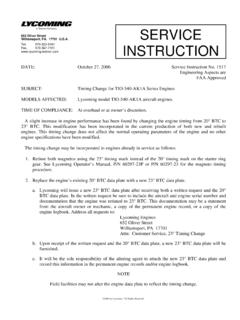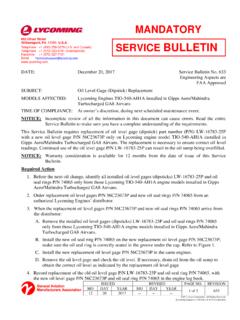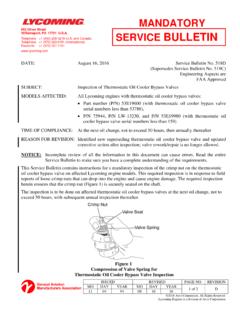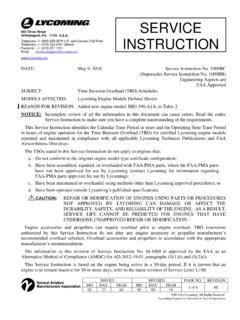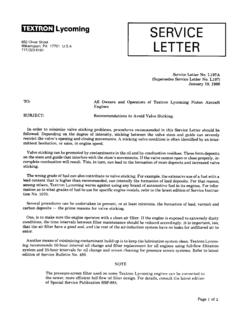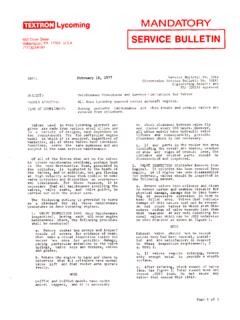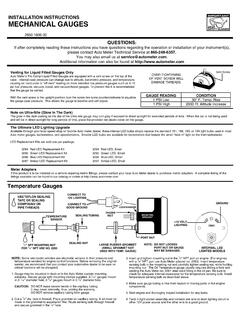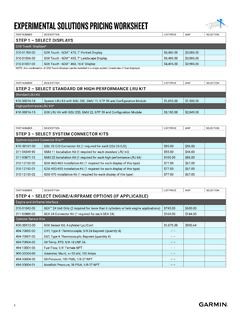Transcription of TROUBLE SHOOTING GUIDE - Lycoming
1 LYCOIIIIIIIIG 652 Oliver Street Williamsport, PA 17701 570/323-6181 Lycoming Reciprocating engine TROUBLE SHOOTING GUIDE Reprint 2006 SSP-475 INTRODUCTION TROUBLE - SHOOTING 1. TROUBLE - SHOOTING is the step-by-step procedure used to determine the cause for a given problem and then selecting the best and quickest way to solve that problem. While the use of turbochargers and automatic controllers has complicated the TROUBLE - SHOOTING procedures, always start by discussing the problem with the pilot and the facility management. They will assist you in narrowing the problem to as few possibilities as possible. In the case of twin engine aircraft, make sure you are working on the correct engine . After a thorough discussion and verbal analysis of the problem.
2 , you are ready to go to work. If you are an experienced mechanic, you may be able to automatically eliminate some of the probable causes. If you are new on the job, you will have to go through all of the probable causes. The important thing to remember is to always start with the simple and inexpensive things first, and then work toward the more complicated, time consuming, and expensive things later. 2. After you have received all possible information from the pilot and the facility management, a quick observation of the external condition of the engine may give you an indication of the problem. Some areas to look at are the intake and exhaust pipes for leaks, the ignition harness, breather, and the engine compartment for excessive oil stains, gas stains or exhaust stains.
3 More information may be gained rather quickly by doing a compression check to locate any low compression cylinders. Do a boroscope inspection to determine the condition of the combustion chamber. Some information that may be obtained is: the presence of excessive carbon deposits may indicate high oil consumption; the lack of carbon deposits may indicate continuous lean engine operation or detonation; and scratched or scored cylinder walls may indicate broken rings. More information may be compiled by removing the spark plugs to inspect the combustion chamber. NOTE Be sure to keep track of which piston pin plugs came out of which cylinder. During reassembly the piston pin plugs must be matched up with the cylinder they came out of Another good TROUBLE - SHOOTING tool is the use of spectrometric oil analysis.
4 To be effective the engine must be in the analysis program for an extended period of time to develop a useful history of periodic samples of oil that were analyzed. The program must be carried out by experienced and reputable people in the oil analysis field. 3. The following list of problems, causes, and solutions was selected because we believe it represents the more common and recurring problems encountered by mechanics when doing TROUBLE - SHOOTING . It should be noted that the list is general in nature, and does apply to both normally aspirated and turbocharged engines. The sequence in which the lists are arranged is not necessarily the exact step-by-step procedure to use, but should be used as a GUIDE to determine all of the possible causes and solutions to a problem.
5 Always keep in mind to do the simple and inexpensive things first, then proceed with the more complicated and expensive things later. This Page Intentionally Left Blank. CONTENTS Page No. 1. HARD STARTING .. 1 - 3 2. ROUGH IDLE .. 3 - 4 3. engine WILL NOT IDLE UNLESS BOOST PUMP IS ON ..4 -5 4. engine WILL NOT IDLE UNLESS BOOST PUMP IS OFF .. 5 5. POOR IDLE CUT-OFF .. 5 - 6 6. HIGH FUEL FLOW .. 6 7. LOW FUEL FLOW .. 6-7 8. engine WILL NOT TURN STATIC RPM .. 7 - 8 9. engine SURGES .. 8 - 9 10. FAILURE OF engine TO DEVELOP RATED POWER .. 9 -11 11. LOSS OF POWER GOING TO ALTITUDE .. 12 12. CANNOT REACH SPECIFIED CRITICAL ALTITUDE .. 13 -15 13. LOW OIL PRESSURE .. 15 -16 14. HIGH OIL CONSUMPTION .. 16 -17 15.
6 HIGH CYLINDER HEAD TEMPERATURE .. 17 -18 16. SPLIT IN MANIFOLD PRESSURE (TWIN engine ) .. 18 -19 17. HIGH OIL TEMPERATURE .. 19 18. HIGH MANIFOLD PRESSURE AT IDLE .. 19 19. HIGH OIL PRESSURE .. 20 20. MANIFOLD PRESSURE FLUCTUATES .. 20 APPENDIX I TROUBLE - SHOOTING THE BENDIX RSA FUEL INJECTOR .. 21 This Page Intentionally Left Blank. HARD STARTING CAUSE SOLUTION PROCEDURE FOR SOLUTION 1. Technique. 1. Refer to the Operator's Manual 1. Solution is self-explanatory. recommended starting procedure. 2. Flooded. 2. Clean engine . 2. Crank engine with throttle full open and mixture in idle cut-off. 3. Throttle valve open too far. 3. Set for approximately 800 RPM. 3. Solution is self-explanatory. 4. Insufficient prime (may be 4.)
7 Increase same. 4. NOTE: Make sure primer is not accompanied by backfIre). leaking. 5. Magneto impulse coupling not 5. Remove and check for binding, or 5. Remove magneto and check that the operating properly. broken impulse spring. spring is not broken and flyweights move freely. Check torque on coupling retaining nut. If unable to locate the problem, remove coupling and check according to latest revision of Service Instruction No. 1189. 6. Defective spark plugs or ignition 6. Inspect and replace or repair as 6. Remove plugs, inspect, clean, and/or wire. necessary. replace as necessary. Visually inspect ignition harness for breaks and cracks. Test leads by removing distributor block from magneto and using a Bendix high tension lead test No.
8 11-8888 or 11-8888-1 or equivalent type equipment. 7. Low voltage at vibrator input. 7. Check with voltmeter and replace 7. Measure voltage between vibrator battery, if necessary. (Be sure terminal marked "in" and ground battery terminals are clean and tight, terminal while operating starter. also check leads for condition.) Must be at least 8 volts on a 12 volt system, or 13 volts on a 24 volt system. 8. Inoperative or defective vibrator. 8. Check and replace vibrator, if 8. If voltage is okay, listen for necessary. interrupted buzzing of vibrator during starting. If no buzzing is heard, either vibrator is defective or the circuit from the "output" terminal on the vibrator to the retard contact assembly is open.
9 Check both switch and retard circuit. Also check for good electrical ground. 9. Retard contact assembly in magneto 9. Check all connections at switch and 9. Retard points may not be closing not operating electrically. engine vibrator. Adjust retard points. See due to improper adjustment or may may "kick back" during cranking. appropriate Bendix Manual for not have a good electrical procedures. connection in circuit. Check for good contact of switch and retard leads at magneto and vibrator. Check condition of wire. 10. Vibrator - Magneto combination not 10. Check and replace, if necessary. 10. Disconnect Starter and all Snark putting out electrically. Plug Leads. Turn engine in right direction until retard points open on #1 cylinder fIring position.
10 Hold #1 plug lead approximately 3/16 in. from ground, energize vibrator by turning switch to start. Plug lead should throw a show of sparks to ground. If spark is weak or missing, replace vibrator. Also check magneto for correct internal timing. Proper duration of shower of sparks maybe HART STARTING (CONT.) CAUSE SOLUTION PROCEDURE FOR SOLUTION 10. Vibrator -Magneto combination not 10. Check and replace, if necessary. 10. (Cont.) checked by holding switch in putting out electrically. (Cont.) (Cont.) start position, and hand turning propeller until sparks stop. of propeller rotation may be measured or estimated to determine if retard points are adjusted properly. NOTE: All checks must be made with starter and ~lug leads disconnected.
